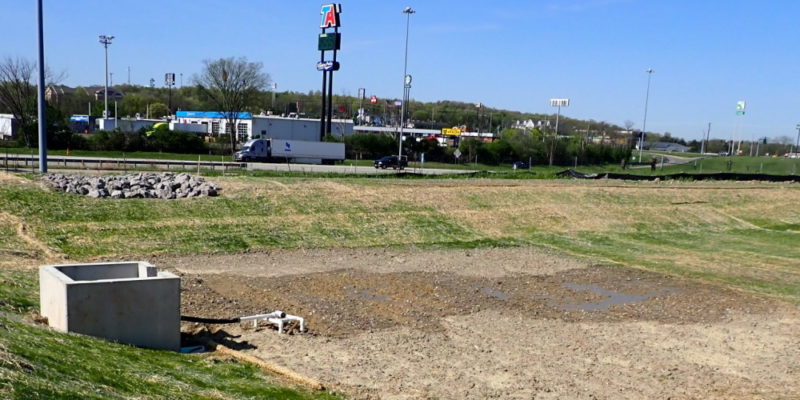
Preventing Storm Water Pollution: An Important Investment
One of the most important functions of the Mahoning County Soil & Water Conservation District is protecting Mahoning County’s surface waters, the source of much of our drinking water and quite a bit of our recreation.
We collaborate with other government agencies to manage what is known as the county’s “MS4,” its combination of ditches, retention/detention basins, roadside inlets and underground pipes that collect storm water from developed areas and eventually discharge it to rivers and streams without treatment.
(MS4 stands for “Municipal Separate Storm Sewer System,” meaning a system that’s separate from a sanitary sewer system.)
The SWCD provides this protection in several ways.
One is our work with the Mahoning County Engineer’s Office, the lead agency for the county storm water management plan. The SWCD provides technical support in the review of storm water pollution prevention plans developers need to file if their work will disrupt the flow of storm water.
We also provide construction site inspections in support of these permits. Our staff visits sites regularly to confirm that required storm water management practices are being followed as described in the permits.
We also provide technical education support. Examples include:
- Preconstruction meetings prior to any earth-moving activity
- On-site meetings with contractors, engineers, architects, foremen and crew to discuss drainage and erosion prevention
- Response to public concerns regarding drainage and erosion
“Storm water pollution prevention is an important investment,” said Kathi Vrable-Bryan, district administrator. “The more we take care of our surface water up front, the less costly it will be for treatment.
“The MS4 program protects surface bodies of water that provide our drinking water and support recreational purposes and the wildlife we view and enjoy.”
Here are some questions and answers about storm water pollution prevention:
How does storm water flow affect the environment?
When it rains, storm water washes over loose soil on construction sites, along with various materials and products stored outside. As storm water flows, it can pick up pollutants like sediment, debris and chemicals from that loose soil and transport them to nearby storm sewer systems or directly into rivers or lakes.
The Ohio EPA, County Engineer’s Office, SWCD and other agencies work with construction site operators to make sure they have the proper storm water controls in place so that construction can proceed in a way that protects our community’s clean water and the surrounding environment.
What kinds of pollutants can be found in storm water runoff?
Per the Ohio EPA, sediment is the top pollutant in Ohio. Pure sediment is not a pollutant, but pollutants adhere to sediment, which can be carried by storm water to streams, lakes and rivers. These pollutants are commonly associated with construction sites:
- Solid and sanitary wastes
- Phosphorus
- Nitrogen
- Pesticides
- Oil and grease
- Concrete truck washout
- Construction chemicals
- Construction debris
What areas of government service are most important to prevent storm water pollution?
The U.S. EPA encourages every county to include these “minimum control measures,” or MCMs, in its storm water management planning.
- Public education and outreach on storm water impacts
- Public involvement and participation
- Illicit discharge detection and elimination
- Construction site storm water runoff erosion controls
- Post-construction storm water management in new development and redevelopment
- Pollution prevention/good housekeeping for municipal operations
What specific construction activities are regulated here in Mahoning County?
A permit is required for storm water discharges from any construction activity that disturbs:
- 1 acre or more of land, or
- Less than 1 acre of land that is part of a common plan of development or sale that will ultimately disturb 1 or more acres of land.
Construction activity includes earth-disturbing activities such as clearing, grading and excavating land and other construction-related activities that could generate pollutants.
____
We would like to respectfully recognize that some of this information was referenced from the Mahoning County Storm Water Management Plan, Penn State Extension Office, U.S. EPA and Ohio EPA.
Management of outlet structures like these is important to controlling runoff of storm water from construction sites.
